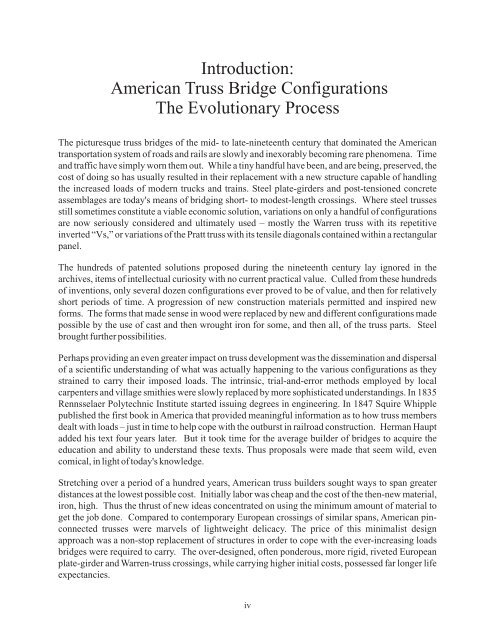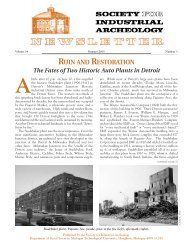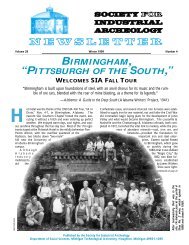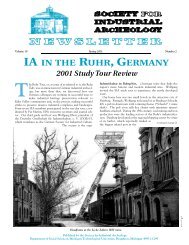Occasional Electronic Publication No. 1 - Society for Industrial ...
Occasional Electronic Publication No. 1 - Society for Industrial ...
Occasional Electronic Publication No. 1 - Society for Industrial ...
Create successful ePaper yourself
Turn your PDF publications into a flip-book with our unique Google optimized e-Paper software.
Introduction:<br />
American Truss Bridge Configurations<br />
The Evolutionary Process<br />
The picturesque truss bridges of the mid- to late-nineteenth century that dominated the American<br />
transportation system of roads and rails are slowly and inexorably becoming rare phenomena. Time<br />
and traffic have simply worn them out. While a tiny handful have been, and are being, preserved, the<br />
cost of doing so has usually resulted in their replacement with a new structure capable of handling<br />
the increased loads of modern trucks and trains. Steel plate-girders and post-tensioned concrete<br />
assemblages are today's means of bridging short- to modest-length crossings. Where steel trusses<br />
still sometimes constitute a viable economic solution, variations on only a handful of configurations<br />
are now seriously considered and ultimately used – mostly the Warren truss with its repetitive<br />
inverted “Vs,” or variations of the Pratt truss with its tensile diagonals contained within a rectangular<br />
panel.<br />
The hundreds of patented solutions proposed during the nineteenth century lay ignored in the<br />
archives, items of intellectual curiosity with no current practical value. Culled from these hundreds<br />
of inventions, only several dozen configurations ever proved to be of value, and then <strong>for</strong> relatively<br />
short periods of time. A progression of new construction materials permitted and inspired new<br />
<strong>for</strong>ms. The <strong>for</strong>ms that made sense in wood were replaced by new and different configurations made<br />
possible by the use of cast and then wrought iron <strong>for</strong> some, and then all, of the truss parts. Steel<br />
brought further possibilities.<br />
Perhaps providing an even greater impact on truss development was the dissemination and dispersal<br />
of a scientific understanding of what was actually happening to the various configurations as they<br />
strained to carry their imposed loads. The intrinsic, trial-and-error methods employed by local<br />
carpenters and village smithies were slowly replaced by more sophisticated understandings. In 1835<br />
Rennsselaer Polytechnic Institute started issuing degrees in engineering. In 1847 Squire Whipple<br />
published the first book in America that provided meaningful in<strong>for</strong>mation as to how truss members<br />
dealt with loads – just in time to help cope with the outburst in railroad construction. Herman Haupt<br />
added his text four years later. But it took time <strong>for</strong> the average builder of bridges to acquire the<br />
education and ability to understand these texts. Thus proposals were made that seem wild, even<br />
comical, in light of today's knowledge.<br />
Stretching over a period of a hundred years, American truss builders sought ways to span greater<br />
distances at the lowest possible cost. Initially labor was cheap and the cost of the then-new material,<br />
iron, high. Thus the thrust of new ideas concentrated on using the minimum amount of material to<br />
get the job done. Compared to contemporary European crossings of similar spans, American pinconnected<br />
trusses were marvels of lightweight delicacy. The price of this minimalist design<br />
approach was a non-stop replacement of structures in order to cope with the ever-increasing loads<br />
bridges were required to carry. The over-designed, often ponderous, more rigid, riveted European<br />
plate-girder and Warren-truss crossings, while carrying higher initial costs, possessed far longer life<br />
expectancies.<br />
iv






